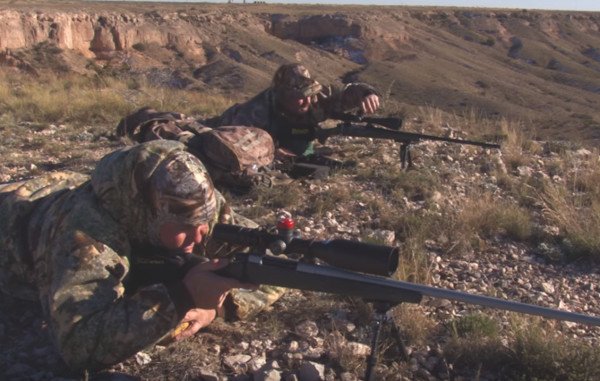In a recent YouTube video a hunter makes a kill from more than 1,300 yards. And while I’m not an advocate of long range hunting (I’d rather be a good hunter than a good shooter), it’s still impressive.
But before you go out and start practicing shots more than a half-mile away, here’s a few things you need to know.
First, be prepared to spend a truck load of money as some of the long distance scopes can run you more than $3,000. Then you need to get a good spotting scope and tripod, a laser range finder, a Kestrel pocket weather station to determine elevation, humidity, barometric pressure and temperature.
Oh, and don’t forget to have the proper caliber bullet (.30-378 Weatherby, .220 Swift or a 7mm Rem Mag).
Now that your wife’s good and mad at you, you’re ready to go out and practice. It’s quite easy (if you’re a trained military sniper or don’t have a full time job). Here’s what you do according to an article in Long Range Hunting Magazine.
Assume a solid shooting position, do whatever it takes to achieve this.
- Get an accurate yardage to the target.
- Factor in atmospheric condition changes from your zero conditions.
- Uphill / Downhill corrections
- Wind velocity and direction estimation
- Correct for elevation and or windage
- Lock into your shooting position
- Wait for the shot you want to have
- Last second wind check
- Fire
- Spot your shot
- Follow up if necessary
See how easy that was? Now all you have to do is go out and locate some game that’s really far away! All kidding aside, some situations require a long shot and most of us don’t know a thing about reticle illumination, focal planes or MOA’s. The average hunter hunts because he gets a rush out of the stalk, the ability to meet the game eye to eye, on it’s turf.
While most avid hunters know when a shot is too far away, there are times when some knowledge of long-range shooting is necessary. Most hunters sight their rifles in so that they’re about an inch high at 100 yards. This has worked well for me over the years.
Like anything else, practice makes perfect. I love to go out and practice those long shots in the off-season. When I’m dialed in at 100 yards, I can go back to 200 or 300 yards and do some easy math to determine how much I need to compensate.
Wind is always one of the biggest factors and I’m a big fan of the tried and true “Kentucky windage” method of simply correcting for windage by adjusting your aim point. It’s kind of like leading a duck and with a little practice on windy days, you will find that you are still within the kill zone at longer distances.
The bottom line is that long range hunting is a completely different animal. Some places have very limited cover and you have to shoot from far away. Usually, when you go to one of these places, you will have a guide to help you make the proper shot.
I’ll stick with my opinion that hunting is not about seeing how accurate you are from a mile away but more about using your skill and experience to get as close as possible. That, to me, is what hunting is all about.
Photo credit: Youtube








